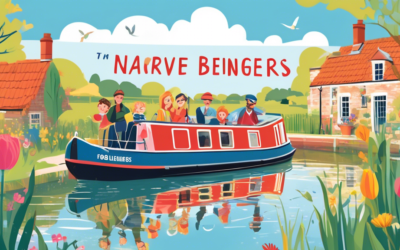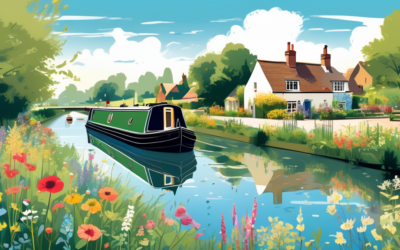Reviving Waterways: Success Stories in Canal Restoration
Waterways once served as the lifeblood of the industrial revolution, providing essential routes for the transport of goods and materials across the country. As time marched on and alternative forms of transportation gained dominance, many of these canals fell into disuse and disrepair. However, thanks to the efforts of passionate communities, heritage organizations, and local governments, canal restoration has gathered pace in recent years. Restoring these historic waterways not only preserves a crucial part of our heritage but also brings a multitude of environmental, economic, and social benefits. Let’s dive into some inspiring success stories in canal restoration, especially focusing on the picturesque canals in the North West of England, including the Four Counties, Cheshire Ring, and Llangollen Canal.
The Llangollen Canal: A Flourishing Waterway
The Llangollen Canal, famous for its scenic beauty and the remarkable feat of engineering that is the Pontcysyllte Aqueduct, is a prime example of successful waterway restoration. Originally constructed in the early 19th century to serve the industries of North Wales, it had begun to decline by the mid-20th century. The turning point came when communities along its route, recognizing its potential for tourism and leisure, rallied for its restoration. Today, the Llangollen Canal is a bustling hub for canal boat enthusiasts, walkers, and nature lovers. The restoration of the canal and the aqueduct’s recognition as a UNESCO World Heritage Site have catapulted this waterway into the limelight, showcasing the potential for restored canals to boost local tourism and economy.
Enhancing Biodiversity along the Cheshire Ring
The Cheshire Ring, with its 97 miles of waterways circling through the heart of Cheshire, Manchester, and parts of Lancashire, presents another encouraging story of revival. Beyond the obvious aesthetic and historical significance, the restoration of the Cheshire Ring has had profound impacts on local biodiversity. The canal paths, once overgrown and neglected, have been transformed into vibrant habitats for wildlife. Efforts such as planting native species along the banks, creating wetlands adjacent to the canals, and installing fish passes have enriched the ecosystem, attracting a diverse array of birds, insects, and aquatic life. This increased biodiversity not only enhances the natural beauty of the area but also serves an essential educational purpose, offering locals and visitors alike a glimpse into the rich tapestry of life that thrives in well-maintained waterways.
The Four Counties Ring: A Testament to Collaboration
The restoration of the Four Counties Ring is a testament to the power of community collaboration and dedication. This circular route, covering Staffordshire, Shropshire, Cheshire, and the West Midlands, encountered numerous challenges during its revival, including structural damages to locks, bridges, and aqueducts. It was the tireless work of volunteers and the support of local councils and the Canal & River Trust that turned the tide for the Four Counties Ring. Working bees were organized to clear debris, repair towpaths, and even reconstruct collapsed canal sections. Today, the Four Counties Ring stands as a vibrant navigation route, revered by boating enthusiasts for its beautiful countryside and diverse landscapes. It exemplifies how collaboration and community spirit can breathe new life into historic canals, transforming them into cherished spaces for recreation and nature conservation.
A Catalyst for Economic Revitalization
The restoration of these canals has not only revived the waterways themselves but has also been a catalyst for economic revitalization in surrounding areas. Anecdotes abound of local businesses experiencing a resurgence as a result of increased canal tourism. From canal boat hire companies and waterside pubs to local craft shops and B&Bs, the economic ripple effects of these restoration efforts are palpable. Moreover, restored canals contribute to creating more sustainable modes of transport and encouraging outdoor activities, aligning with broader environmental goals.
Lessons from the Past, Hopes for the Future
The success stories of the Llangollen Canal, Cheshire Ring, and the Four Counties Ring offer valuable lessons for future restoration projects. They highlight the importance of community involvement, the potential for enhancing biodiversity, and the economic benefits that revitalized waterways can bring to an area. These stories are not just about reinvigorating old waterways but also about creating a legacy for future generations to enjoy and cherish.
As we look to the future, the aim is to continue this momentum, ensuring that more disused canals are brought back to life. The path forward includes embracing new technologies for sustainable management, fostering stronger community ties, and advocating for supportive policies that recognize the multifaceted value of our historic canals. In doing so, we not only preserve a key piece of our heritage but also create vibrant, living waterways that enrich our landscapes and lives.
Restoring our historic canals is a testament to what we can achieve when we come together with a shared vision. It’s an ongoing journey of transformation—one that promises to keep our waterways flowing with life, history, and the endless possibility for discovery. Let’s continue to champion these vital waterways, ensuring they remain an integral part of our communities and continue to tell their stories for generations to come.
Fancy a boat holiday – Check out Floating Holidays fleet for hire!






0 Comments